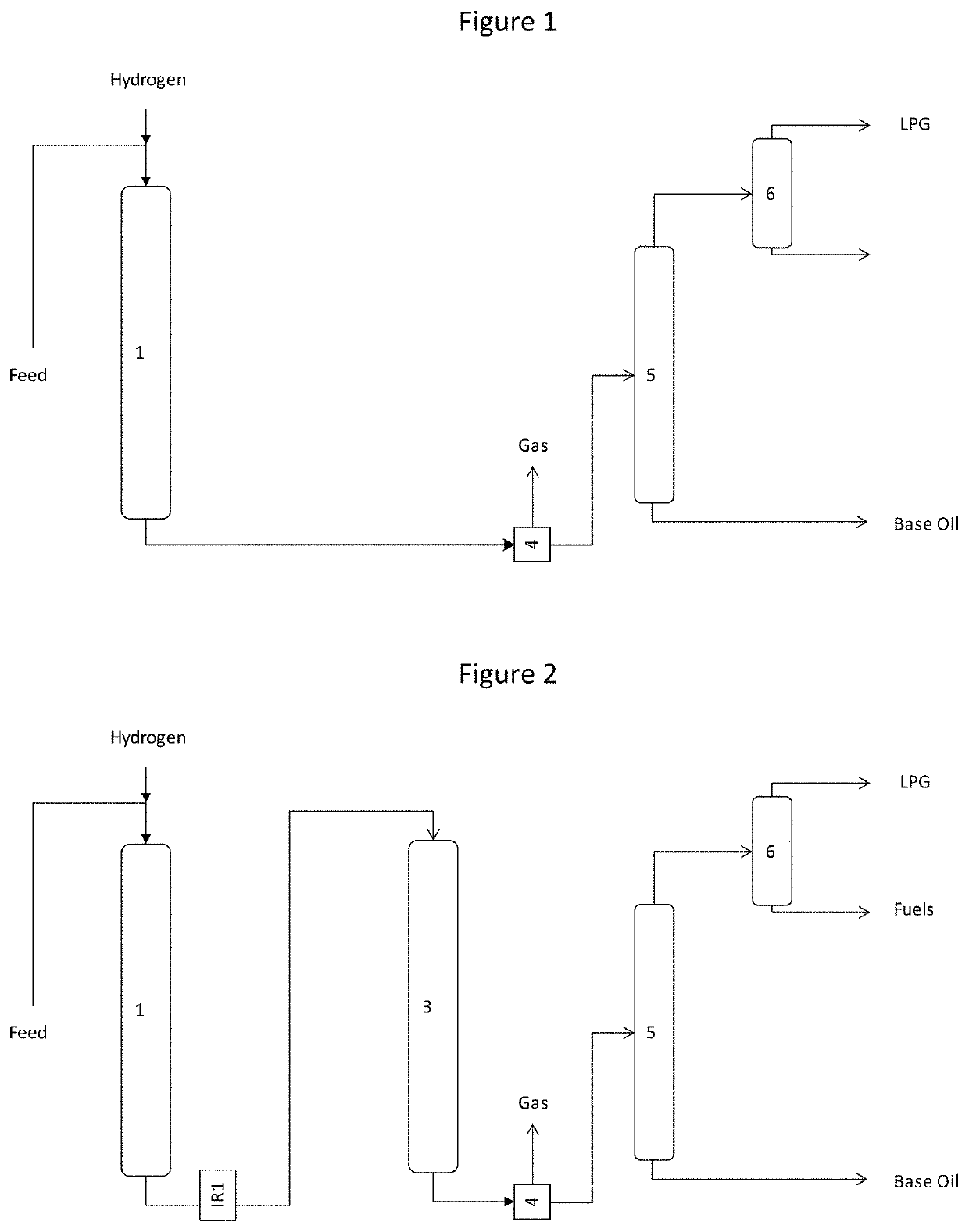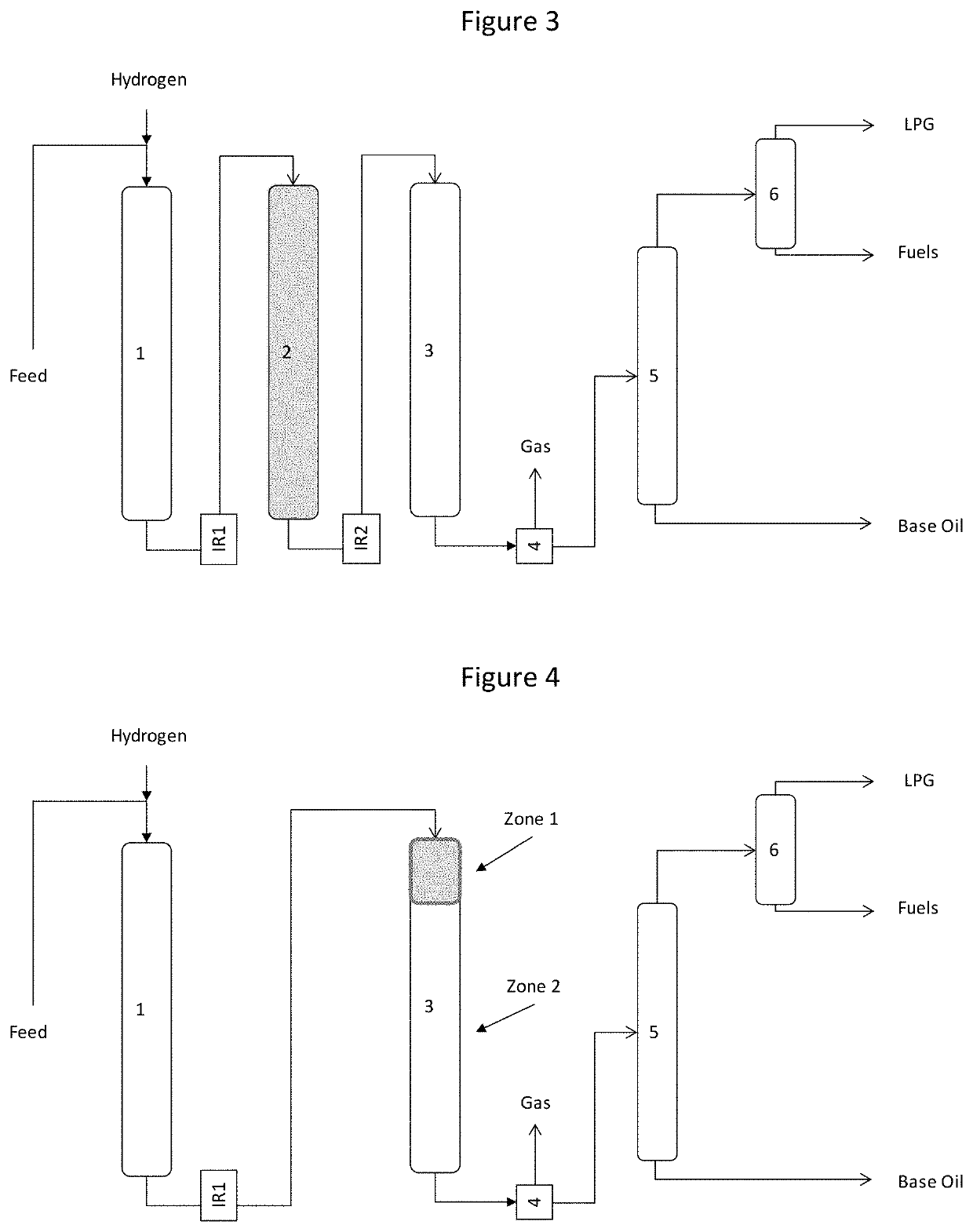Method for producing high quality base oils using multiple stage processing
a technology of base oil and processing method, which is applied in the direction of hydrocarbon oil treatment products, metal/metal-oxide/metal-hydroxide catalysts, physical/chemical process catalysts, etc., can solve the negative impact of pouring and clouding points of fractions, base oil still may have undesirable levels of aromatics, residual organic sulfur, and/or nitrogen, etc., to improve the low temperature properties, and improve the viscosity index
- Summary
- Abstract
- Description
- Claims
- Application Information
AI Technical Summary
Benefits of technology
Problems solved by technology
Method used
Image
Examples
example 3
[0080]Example 3 includes stage 1, 2 and 3 followed by product separation systems 4, 5 and 6 as shown in, for example, FIG. 3 simplified process flow scheme. A noble metal hydroisomerization catalyst was installed in the 1st stage reactor. After passing the 1st stage, the effluent was first treated with a base metal catalyst-Ni BASF in the 2nd stage reactor and then sent to the 3rd stage reactor, which was loaded with a Pd / Pt catalyst to further improve the lube product quality. The hydrogen to oil ratio was about 3000 scfb. The lube product was separated from fuels through the distillation section. Product aromatics content was determined.
[0081]FIG. 3 key: 1—1st stage, 2—2nd stage, 3—3rd stage, 4—High pressure seperator, 5—Distillation system, 6—Debutanizer.
[0082]The 1st stage reactor was operated at 600-650° F. to convert the wax molecules to reach the product pour point target. The 3rd stage reactor was operated at ˜450° F. to saturate the single-ring and multi-ring aromatics to i...
example 4
[0083]Example 4 includes stages 1 and 3 followed by product separation systems 4, 5, and 6. This is shown in FIG. 4 simplified process flow scheme. A noble metal hydroisomerization catalyst was installed in the 1st stage reactor. After passing the 1st stage, the effluent was then hydrofinished in the 3rd stage reactor. Comparing to comparative example 2, a layering catalyst system was applied in the 3rd stage reactor for example 4, which includes 10 vol. % base metal catalyst Ni-BASF on top (Zone 1) followed by 90 vol. % noble metal hydrofinishing catalyst (Zone 2). The hydrogen to oil ratio was about 3000 scfb. The lube product was separated from fuels through the distillation section. Product aromatics content was determined.
[0084]FIG. 4 key: 1—1st stage, 3—3rd stage (Base metal zone and noble metal zone), 4—High pressure seperator, 5—Distillation system, 6—Debutanizer.
[0085]The 1st stage reactor was operated at 600-650° F. to convert the wax molecules to reach the product pour po...
PUM
| Property | Measurement | Unit |
|---|---|---|
| Temperature | aaaaa | aaaaa |
| Temperature | aaaaa | aaaaa |
| Temperature | aaaaa | aaaaa |
Abstract
Description
Claims
Application Information
 Login to View More
Login to View More - R&D
- Intellectual Property
- Life Sciences
- Materials
- Tech Scout
- Unparalleled Data Quality
- Higher Quality Content
- 60% Fewer Hallucinations
Browse by: Latest US Patents, China's latest patents, Technical Efficacy Thesaurus, Application Domain, Technology Topic, Popular Technical Reports.
© 2025 PatSnap. All rights reserved.Legal|Privacy policy|Modern Slavery Act Transparency Statement|Sitemap|About US| Contact US: help@patsnap.com


